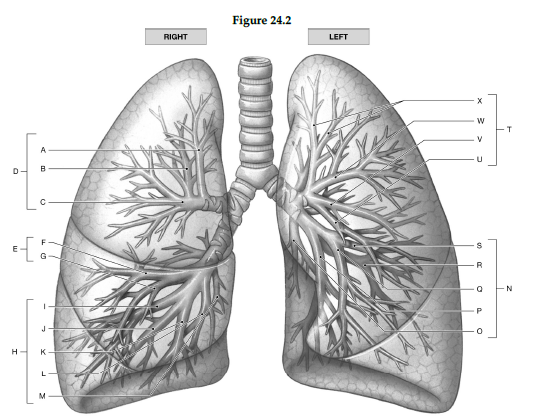Using the figure below, identify the labeled part.

1) Label A: ______________________________
2) Label B: ______________________________
3) Label C: ______________________________
4) Label D: ______________________________
5) Label E: ______________________________
6) Label F: ______________________________
7) Label G: ______________________________
8) Label H: ______________________________
9) Label I: ______________________________
10) Label J: ______________________________
11) Label K: ______________________________
12) Label L: ______________________________
13) Label M: ______________________________
14) Label N: ______________________________
15) Label O: ______________________________
16) Label P: ______________________________
17) Label Q: ______________________________
18) Label R: ______________________________
19) Label S: ______________________________
20) Label T: ______________________________
21) Label U: ______________________________
22) Label V: ______________________________
23) Label W: ______________________________
24) Label X: ______________________________
1) Apical bronchopulmonary segment
2) Posterior bronchopulmonary segment
3) Anterior bronchopulmonary segment
4) Bronchopulmonary segments of superior lobe
5) Bronchopulmonary segments of middle lobe
6) Lateral bronchopulmonary segment
7) Medial bronchopulmonary segment
8) Bronchopulmonary segments of inferior lobe
9) Anterior basal bronchopulmonary segment
10) Lateral basal bronchopulmonary segment
11) Posterior basal bronchopulmonary segment
12) Medial basal bronchopulmonary segment
13) Superior bronchopulmonary segment
14) Bronchopulmonary segments of inferior lobe
15) Superior bronchopulmonary segment
16) Posterior basal bronchopulmonary segment
17) Medial basal bronchopulmonary segment
18) Lateral basal bronchopulmonary segment
19) Anterior basal bronchopulmonary segment
20) Bronchopulmonary segments of superior lobe
21) Inferior lingular bronchopulmonary segment
22) Superior lingular bronchopulmonary segment
23) Anterior bronchopulmonary segment
24) Apicoposterior bronchopulmonary segment
You might also like to view...
The autonomic nervous system may cause activation or inhibition, depending on the division that is active and the target that is affected
Indicate whether the statement is true or false
The inferior point of the heart is called the
A) base. B) apex. C) inferior border. D) right border. E) left border.
It would be appropriate to insert a nasopharyngeal airway in patients who:
A) are unresponsive with multiple facial bone fractures. B) have an altered mental status with an intact gag reflex. C) are semiconscious with active vomiting and cyanosis. D) have CSF leakage from the nose and are semiconscious.
If one inspires through their nose, which of the following answers has the correct order of structures the air would move through?
A. Nares ? Vestibule ? Nasal Cavity ? Nasopharynx ? Oropharynx ? Laryngopharynx ? Larynx ? Trachea ? Bronchiole ? Respiratory Bronchiole ? Terminal Bronchiole ? Primary Bronchus ? Secondary Bronchus ? Tertiary Bronchus ? Alveolar Duct ? Alveolar Sac ? Alveolus B. Nares ? Nasal Cavity ? Vestibule ? Nasopharynx ? Oropharynx ? Laryngopharynx ? Larynx ? Trachea ? Primary Bronchus ? Secondary Bronchus ? Tertiary Bronchus ? Bronchiole ? Respiratory Bronchiole ? Terminal Bronchiole ? Alveolar Duct ? Alveolar Sac ? Alveolus C. Nares ? Nasal Cavity ? Vestibule ? Nasopharynx ? Oropharynx ? Laryngopharynx ? Larynx ? Trachea ? Primary Bronchus ? Secondary Bronchus ? Tertiary Bronchus ? Bronchiole ? Terminal Bronchiole ? Respiratory Bronchiole ? Alveolar Duct ? Alveolar Sac ? Alveolus D. Nares ? Vestibule ? Nasal Cavity ? Nasopharynx ? Oropharynx ? Laryngopharynx ? Larynx ? Trachea ? Primary Bronchus ? Secondary Bronchus ? Tertiary Bronchus ? Bronchiole ? Terminal Bronchiole ? Respiratory Bronchiole ? Alveolar Duct ? Alveolar Sac ? Alveolus